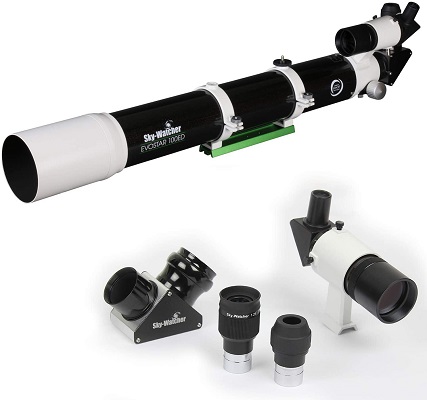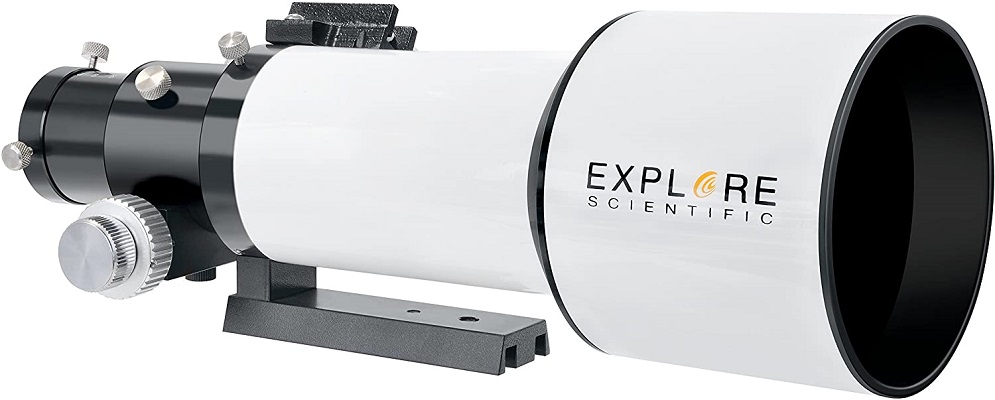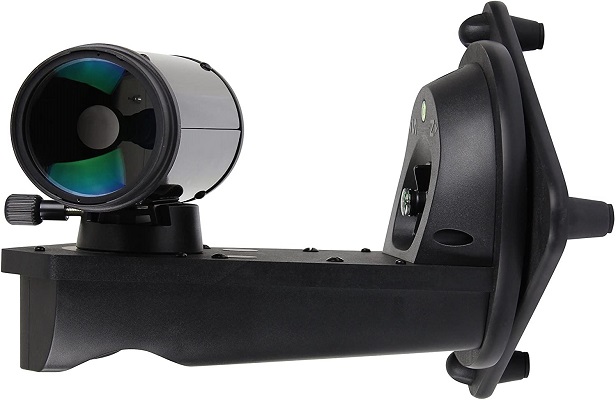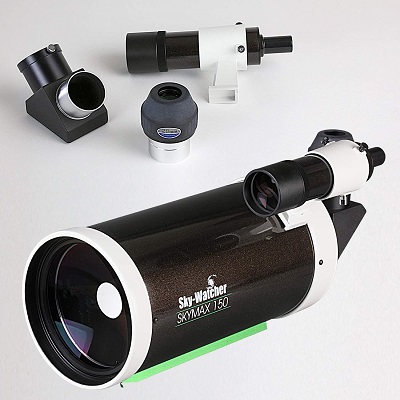If you’re into astrophotography, you need a telescope that will enable you to capture the fascinating celestial phenomena in all their splendor.
The best telescope for astrophotography should have a fast focal ratio, high-quality optics, and a mount that ensures precise tracking.
To help you find an astrophotography telescope that will help you capture breathtaking photos of star clusters, nebula, and galaxies, we have narrowed down the best telescopes that are optimized and top rated for astrophotography. Check out our top picks below.
Disclosure: This article includes affiliate links that may provide a commission to me at no cost to you if you make a purchase through those links.
Table of Contents
What are the Best Telescopes for Astrophotography?
Best Overall: Sky-Watcher EvoStar APO Doublet Refractor Telescope

Overview
The Sky-Watcher EvoStar APO Doublet refractor telescope was designed with astrophotography in mind. It’s equipped with a 2-inch dual-speed focuser that minimizes shaking and the optical tube features baffles that reduce stray light.
Furthermore, the telescope uses ED doublet lens that features extra-low dispersion glass and metallic coatings to deliver the best color correction eliminating chromatic aberration. All these features work together to deliver jaw-dropping images of celestial phenomena.
The EvoStar is a very good all-around telescope capable of both high magnification views of planets and wider field views of galaxies, nebulae, and star clusters. Depending on your budget and the kind of celestial objects you will be photographing, you can opt for an 80mm, 100mm, or 120mm aperture telescope.
Key Features
- APO Doublet Refractor Telescope
- 80mm, 100mm, and 120mm aperture size options
- ED optical glass with high-transmission coatings
Pros
- Easy to use and provides great photos even in the hands of a beginner
- A compact design makes it easy to take where you want it
- Superb contrast and color correction and HD resolution
- Dual-speed Crayford-style focuser is smooth in operation
- Baffled to minimize stray light and matte black tube interior prevents light reflections
- Comes in a foam-lined aluminum case
- Great for capturing bright objects as well as wide-field phenomena such as galaxies
- Easy to setup and cools down quickly
Cons
- The focuser is only of medium-level quality which is an issue when using heavier eyepieces
Pricing
Bottom Line
If you’re looking for the perfect balance between stellar images and portability, the Sky-Watcher EvoStar won’t disappoint. It’s also amazing value for an ED Refractor telescope.
Best for Deep Space Astrophotography: Explore Scientific ED 80 Air Spaced Triplet Telescope

Overview
Being a true triplet APO, the Explore Scientific ED 80 Air Spaced Triplet captures spectacular images of deep space objects. Even if you’ve never photographed the night sky before, you will be able to capture top-quality images without a steep learning curve to conquer.
The build quality is top-notch and the telescope is compact and lightweight for ease of maneuvering wherever you want to set up. It makes a fantastic telescope for grab-and-go use as well.
Key Features
- Air Spaced Triplet ED
- 80mm objective diameter
- 480mm focal length
- F6 focal ratio
- EMD Coatings
Pros
- A true triplet APO refractor telescope
- Fast focal ratio for deep space astrophotography
- Great telescope for grab and go usage
- Compact and lightweight thus easy to handle
- Easy to use even for beginner astro-imagers
- Sturdy build great, build to last years
Cons
- The mount it comes with has a lot of play
Pricing
Bottom Line
The Explore Scientific ED 80 is a top-rated telescope for deep space astrophotography of distant phenomena. If you’re looking to capture awe-inspiring photos of galaxies, nebulas, and star clusters, you can’t go wrong here.
Best Bang for the Buck: Sky Watcher Evostar 72 APO Telescope

Overview
The Sky-Watcher Evostar 72 APO delivers great wide fields images which is exactly what you need for astrophotography of deep space phenomena. It captures stunning photos of nebulae, galaxies, and star clusters such as the Andromeda, Orion, and the Pleiades.
It’s also incredibly easy to use even for first-time users. It even has a dual-speed focuser for ease of focusing on whatever you’re imaging. As an APO refractor at a great price (under $600), the quality-price ratio is unparalleled.
Key Features
- APO Refractor Telescope
- 72mm objective diameter
Pros
- Excellent wide field view for deep space astro-photography
- Lightweight thus easy to carry wherever you need it
- Easy to setup and focus even for beginners
- Excellent optics at an accessible price
- Sturdy build quality and aluminum case
Cons
- You will have to purchase additional accessories such as a field flattener separately
Pricing
Bottom Line
Whether you’re a beginner or a seasoned amateur astronomer looking for a great astrophotography telescope at a budget-friendly price, the Sky-Watcher Evostar 72ED is worth a look.
Best Premium: Celestron CPC 800 XLT Computerized Telescope

Overview
The Celestron CPC 800 XLT Computerized Telescope is a favorite of many experienced amateur astrophotographers. This is thanks to a computerized mount and internal GPS that makes it easy to seek and track the objects you’re interested in and an optical tube that provides awe-inspiring images of the planets and their features as well as deep space objects such as globular star clusters.
Even though the CPC 800 XLT is an Altazimuth telescope, it’s excellent for even long exposure astrophotography when used with an HD Pro wedge to polar align it and ensure precise tracking. The solid base and heavy-duty tripod also make it easy to focus on what you want to capture without shaking getting in the way.
Key Features
- 8 inch objective diameter
- Computerized altazimuth mount
- Internal GPS receiver
- 203mm focal length
Pros
- Excellent optics of both bright objects and deep space phenomena
- Can be placed on a wedge for polar alignment
- Computerized and GPS enabled to simplify locating and tracking of objects
- Sturdy drive base and heavy duty CPC tripod
- Powerful yet easy to maneuver thanks to carry handles
Cons
- Requires a wedge in order to function well for long exposure photography
- Does not come with a power source for the GPS
Pricing
Bottom Line
Excelling in both visual astronomy and astrophotography, the CPC 800 XLT is an excellent all-around telescope and worth a splurge for any serious amateur astronomer and imager.
Best for Beginners and Kids: Celestron Inspire 100AZ Refractor Telescope

Overview
The Celestron Inspire 100AZ is an easy-to-use refractor telescope for beginners. With a 100mm objective diameter, it packs enough light-gathering power to deliver clear and bright images. You can see and photograph the surface of the moon, the rings of Saturn, and Jupiter’s moons.
Its short tube delivers a wider field of view for viewing and capturing even the objects beyond the solar system such as the Orion Nebula and the Andromeda Galaxy. It comes complete with a smartphone adapter so you can start taking photos of celestial objects right out of the box.
Key Features
- 100mm objective diameter
- f/6.5 focal ratio
- 660mm focal length
- Fully coated glass optics
- Altazimuth mount
Pros
- Beginner friendly, no alignment required
- Wide objective for planetary views
- Short tube delivers stunning wide field views
- Integrated smartphone adapter
- Built-in and removable red LED flashlight
- Great for both terrestrial and astronomical use
Cons
- You will have to upgrade some of the accessories to get the best experience
Pricing
Bottom Line
Easy to use yet delivering amazing optics of both the solar system and deep space objects, the Celestron Inspire 100AZ is the best astrophotography telescope for beginners of all ages, including kids.
Best Grab and Go: Sky-Watcher Virtuoso Telescope

Overview
The Sky-Watcher Virtuoso Telescope comes optimized for imaging celestial objects. It features a motorized alt-azimuth mount for smooth tracking of objects in the night sky and comes with a mounting bracket for a DSLR, camcorder, GoPro, or cell phone.
The optics are stunning, with great contrast and crisp clarity. Most importantly, the telescope measures 14 x 14 x 19 inches and weighs 15lbs making it a great choice of a grab and go telescope that’s easy to carry anywhere and ready to use at a moment’s notice
Key Features
- 90mm objective diameter
- 1250mm focal length
- Motorized alt-azimuth mount
Pros
- Compatible with all types of cameras
- Comes complete with mounting bracket for a camera
- Motorized mount for ease of finding and tracking objects
- Solar filter and Solar finder included
- Automatic shutter release cable for Canon
- Sun Dual Axis Encoders allow you to move the mount without losing alignment
Cons
- Tracking objects in the sky can be a little of a challenge
Pricing
Bottom Line
The Celestron Inspire 100AZ is a terrific value for a grab-and-go scope. The image quality and function are superb for the price. A fantastic choice for the casual astrophotographer.
Best for Lunar and Planetary Imaging: Sky-Watcher Skymax 150mm Telescope

Overview
Thanks to a wide aperture and a long focal length, the Sky-Watcher Skymax 150mm is a great option if you’re looking to image the moon and planets. It provides sharp high contrast views with incredible detail and has a coated corrector plate that gets rid of chromatic aberration. In addition, the tube is fully baffled to keep stray light at bay.
You can see and photograph Jupiter with its cloud bands and moons, the rings of Saturn, and double stars with amazing detail. It’s also good enough for imaging some messier objects such as planetary Nebulae and Globular star clusters.
Key Features
- Compound-Style telescope
- 150mm Objective Diameter
- Altazimuth Mount
Pros
- Top notch optics with no noticeable color aberration
- Altazimuth telescope is easy for a first time user to figure out
- Has an excellent focus range and smooth focus knob
- Compact form factor that’s easy to use
- High performance telescope in a compact and amazing value
Cons
Not very good for photographing deep-sky objects
Pricing
Bottom Line
For a beginner looking to get started in astrophotography by photographing the moon and planets, the Sky-Watcher Skymax 150mm offers a lot of aperture and optics for the buck.
How to Choose the Best Telescope for Astrophotography
The best astrophotography telescope comes down to whether you intend to photograph objects in our solar system, i.e. the moon and the planets, or messier objects in deep space. Here are the features to consider when choosing.
Focal Length and Focal Ratio
A good telescope for photography of wide-field deep space objects such as galaxies, nebula, and globular star clusters should have a fast focal ratio of about f/4. Speed is indicated by the focal ratio, which is calculated by diving the focal length with the aperture.
Telescope Mount
The telescope mount is also a very important consideration when it comes to a telescope for photographing objects in the night sky. Deep-sky astrophotography requires a computerized equatorial mount for precise tracking of objects. This kind of mount has to be polar aligned in order to account for the Earth’s rotation. On the downside, an equatorial mount comes with a steep learning curve for a beginner.
Although an Altitude/Azimuth (ALT/AZ) mount is easy to use and can track an object and keep it centered, it’s not polar aligned and thus not ideal for long exposure shots of objects in the distant skies.
Mirror/Lens Quality
The quality of images you will be able to capture also depends on the quality of mirrors or lens your telescope has. It’s important to choose a telescope equipped with high-quality optics with coatings applied to optimize the image quality. If you’re choosing a refractor, for example, opt for one with extra-low dispersion (ED) glass or go for a triplet APO if your pocket allows.
Aperture Size
A decent objective diameter is still essential for brightness and resolution when imaging dim objects like galaxies. However, it’s not as important as it’s with visual astronomy. You can capture great images even with a smaller telescope with a 50mm aperture.
Ease of use
Lastly, it’s important to consider how easy to use the telescope is. This is especially important when looking for a grab-and-go telescope you can use at the spur of the moment. You might also be after a more advanced telescope that takes time to set up but captures jaw-dropping images, making the extra effort worth it.
Which is the best astrophotography telescope for beginners?
Apochromatic refractors are the ideal astrophotography telescopes for beginners. They are easy to use and consistently capture high-quality images of wide-field phenomena such as galaxies. You don’t have to figure out collimation or deal with flexure and cool down.
Why are refractors better for astrophotography?
Refractor telescopes are like high-end camera lenses. They make it very easy to capture quality Astro-images without much effort. The best refractor telescopes for astrophotography also use ED glass to eliminate chromatic aberration and improve the image quality.
Are reflector telescopes good for astrophotography?
Ritchey-Chretien and reflector telescopes are also great choices for astrophotography. With a reflector, you can capture far more with a given time exposure and at a higher resolution than you can with a small refractor.
A Schmidt-Newtonian telescope also works well for astro-imaging thanks to a corrector plate that helps to reduce coma. On the downside, fast Newtonian reflectors require precise collimation and are not beginner-friendly.
What is the best telescope for deep space astrophotography?
A telescope with a fast focal ratio and wide-field views works best for deep space astrophotography. The Explore Scientific ED 80 Air Spaced Triplet is the best telescope for photographing deep space phenomena such as galaxies and nebula.
That’s a Wrap!
The kind of telescope you use for astrophotography plays a part in determining the quality of images you end up with. Hopefully, our best telescopes for astrophotography reviews and buying guide will make it easier to find a telescope that will enable you to capture professional-level astronomy photos right in your backyard.
